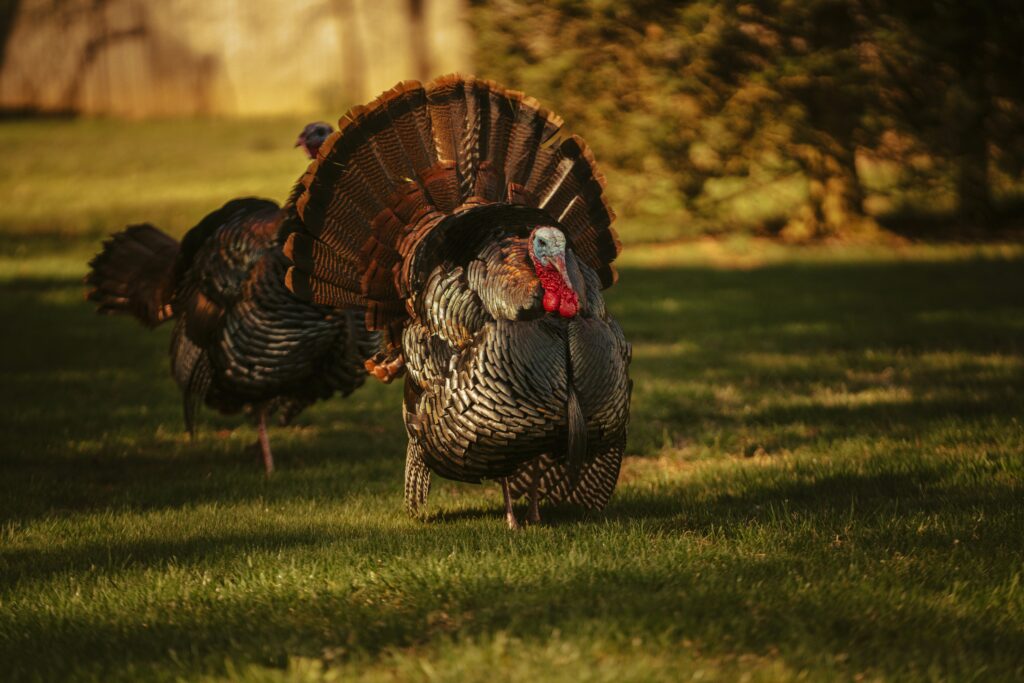Caruncle, wattle, snood and beard
Tom, hen, gobble and strut…
A new language? Some new rap lyrics? Nope! They all refer to Meleagris gallopavo, or the wild turkey.

It’s exciting in the spring to hear a turkey gobble in the distance. It’s yet another signal that the seasons are changing and new life across the wildlife spectrum is soon to come. Wild turkeys, a common sight nowadays, can be found throughout the United States (except for Alaska), Canada and Mexico. If you watch them skulk across the landscape you may be reminded of the velociraptors from Jurassic Park.
From the last 1880s until the 1960s, wild turkeys were not seen in Minnesota because of unregulated hunting and habitat loss due to logging. The late ’60s/early ’70s brought about efforts for reintroduction through a trade with the state of Missouri and the Minnesota DNR. Minnesota traded a flock of homegrown ruffed grouse for 29 Missouri turkeys, which were released in Houston county in southeastern Minn.
This first rafter (group) of turkeys did so well that over the next few years more were trapped and moved northward. One of the release sites was Belwin Conservancy. In 1989, Belwin funded a release of 20 birds on our Education Center property. School children, on a field trip from Saint Paul Public Schools, actually did the release!
A second release at Belwin occurred over the next several years, this time with radio trackers on some of the birds. One of the surprising pieces of data from this was that the birds were moving across the St. Croix River on their own.
Today, turkeys are commonplace and, as a result of the reintroduction success, Minnesota has not one but two turkey hunting seasons. Even if you don’t hunt with a gun, it’s worth it to hunt with your ears and track down a gobbler/tom (male) and watch the majestic strutting they do to impress the hens (females).

Here are just a few amazing fun facts about the wild turkey:
- Turkeys can swim! When they need to, they can swim by tucking their wings in close, spreading their tails and kicking their strong legs.
- Turkeys can hear three times better than humans, which is one reason they are hard to hunt.
- Turkeys can run up to 25 mph, fly 50 feet vertically, and fly at 55 mph in short bursts.
- During mating season, the head of a turkey turns red, white and blue! These three head appendages are signals during the mating season.

What are the parts of a turkey?
- Snood (rhymes with food): The attention-grabbing fleshy appendage that hangs over the beak. Snood size is one of the factors that dictates whether a hen will mate with a tom.
- Caruncle: The noticeable bumps on a turkey’s head. The larger the caruncles, the more testosterone the tom has.
- Wattle, also known as a dewlap: Fleshy appendages that hang from the chin of the turkey. The larger the wattle, the more dominant the tom.
- Beard: These are specialized feathers that resemble horsehair! The longer the beard, the older and more dominant the tom.
During mating season, the snood, caruncle and wattle are like mood rings. They express emotions that can range from confidence to calmness, aggression or submission, depending on the situation.
Resources
Fun Facts About Wild Turkeys
MN DNR Wild Turkey
Turkey Body Language
Turkey Facts
Updated 4/11/21 at 9:03 p.m.